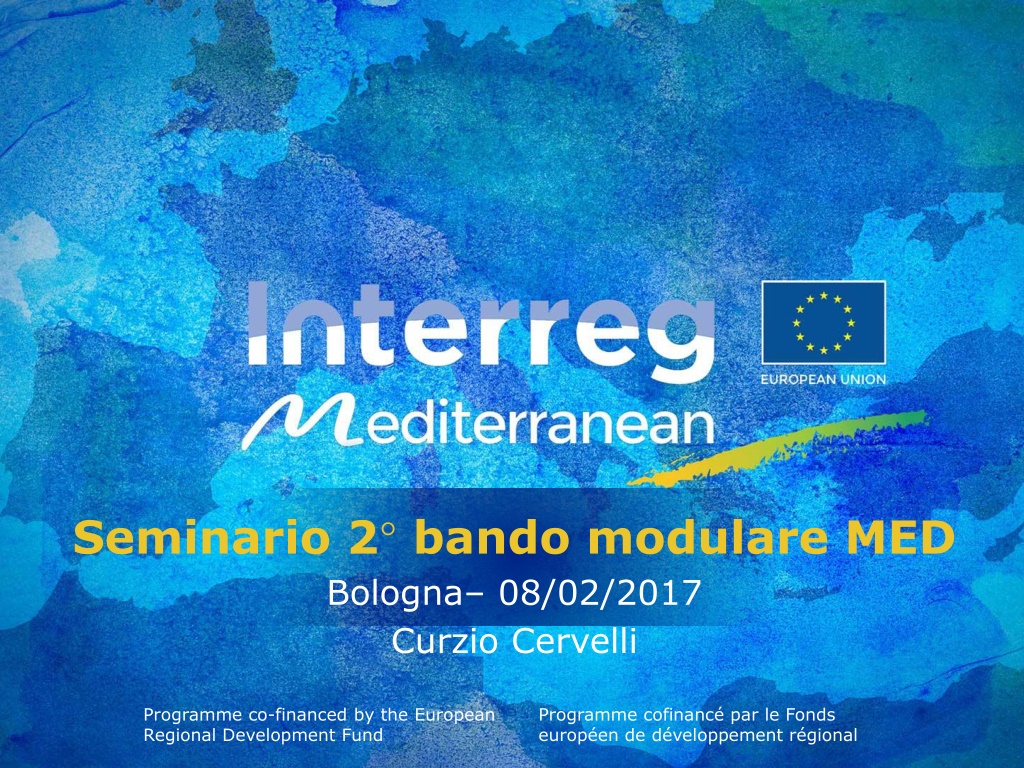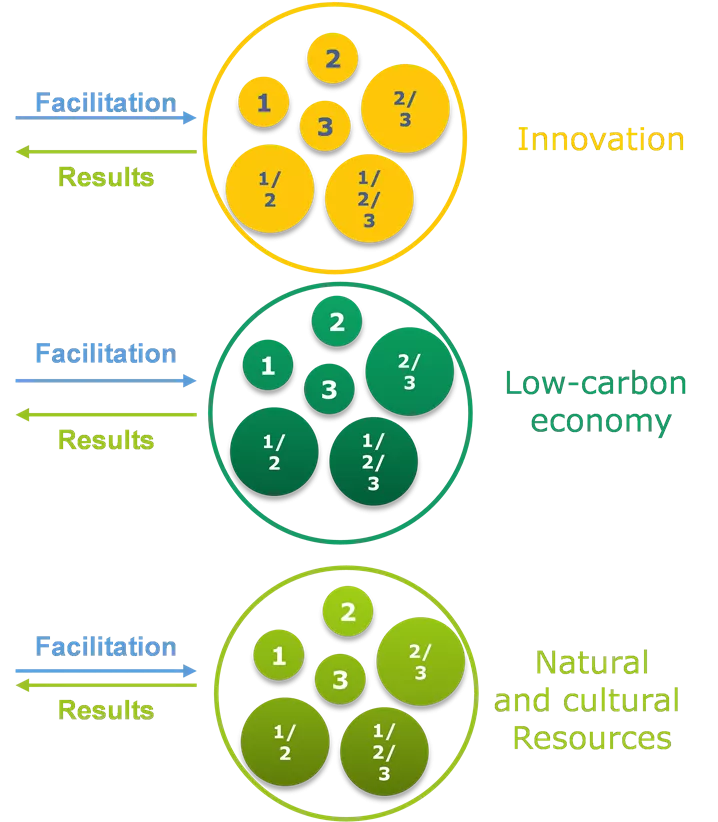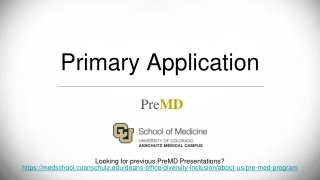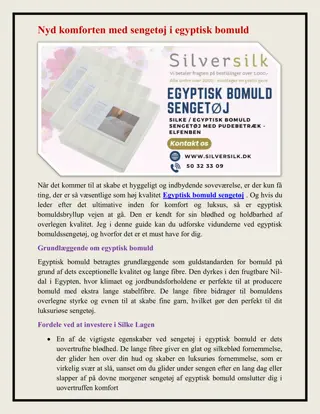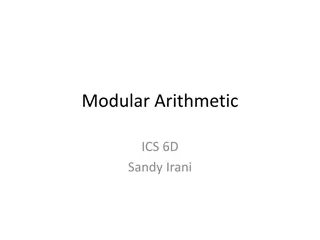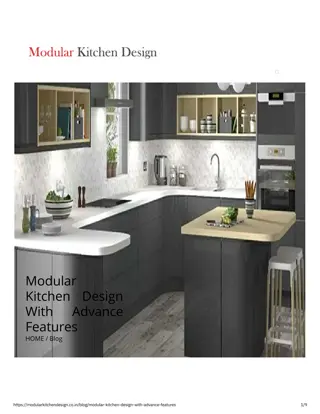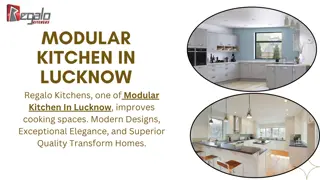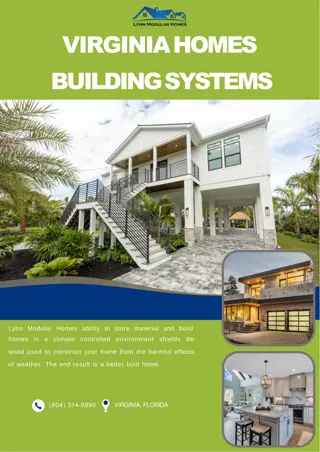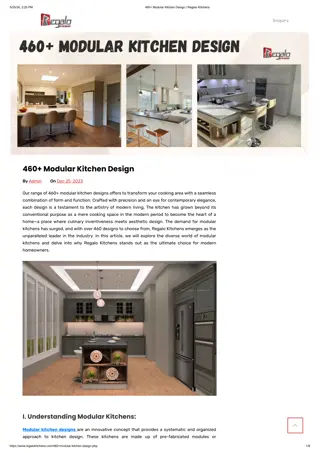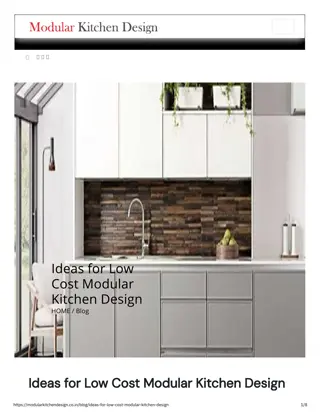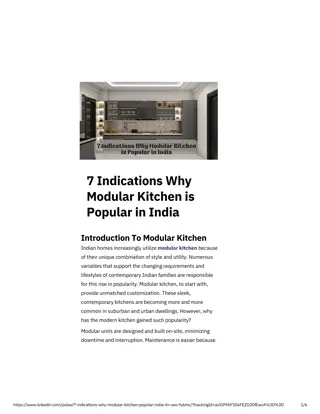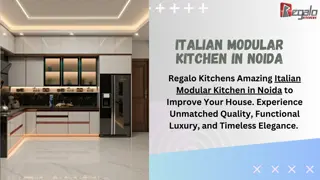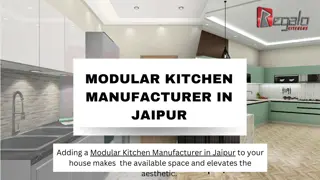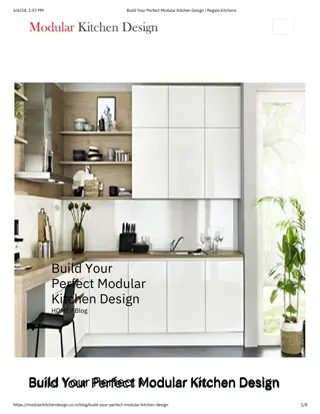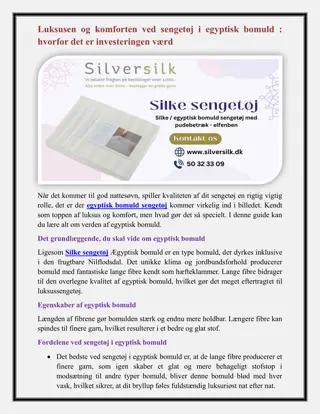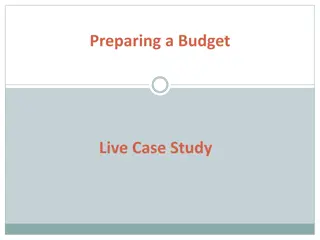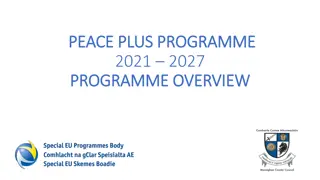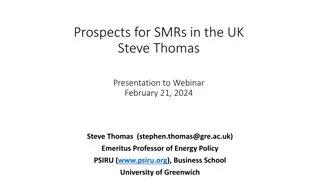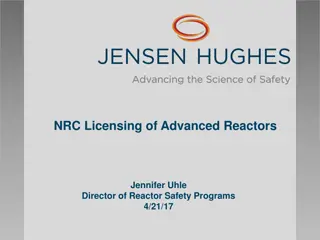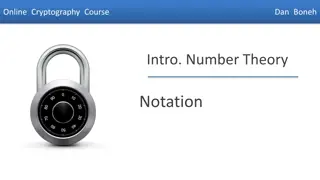Interreg MED Modular Programme Overview
The Interreg MED Modular Programme aims to promote sustainable development in the Mediterranean region through various projects focused on green growth, urban transport, renewable energy, biodiversity protection, efficient buildings, and sustainable tourism. The programme encompasses different levels of impact and strategic themes to address coastal and maritime issues, with a focus on methodologies, evaluation, and communication. With a significant number of projects approved and a strong emphasis on the European Regional Development Fund, the programme seeks to enhance collaboration and drive positive environmental and economic outcomes.
Download Presentation

Please find below an Image/Link to download the presentation.
The content on the website is provided AS IS for your information and personal use only. It may not be sold, licensed, or shared on other websites without obtaining consent from the author.If you encounter any issues during the download, it is possible that the publisher has removed the file from their server.
You are allowed to download the files provided on this website for personal or commercial use, subject to the condition that they are used lawfully. All files are the property of their respective owners.
The content on the website is provided AS IS for your information and personal use only. It may not be sold, licensed, or shared on other websites without obtaining consent from the author.
E N D
Presentation Transcript
Seminario 2 bando modulare MED Bologna 08/02/2017 Curzio Cervelli Programme co-financed by the European Regional Development Fund Programme cofinanc par le Fonds europ en de d veloppement r gional
Programme Architecture 3rdlevel impact Mediterranean SHARED VISION on policies & actions MODULAR projects 1stlevel impact HORIZONTAL projects 2ndlevel impact Local results Thematic transnational communities 2 Facilitation 2/ 3 1 HP Green Growth 3 Innovation HP Blue Growth Results 1/ 2/ 3 1/ 2 HP Social & Creative Axis 4 platform exchanges 2 Facilitation 2/ 3 1 Low-carbon economy HP Efficient Buildings 3 Results 1/ 2/ 3 1/ 2 HP Urban Transport HP Renewable Energy exchanges 2 Facilitation HP Sustainable Tourism 2/ 3 1 Natural and cultural Resources 3 HP Biodiversity Protection Results 1/ 2/ 3 1/ 2
Axis 4 overview WORK PACKAGE 1 Methodologies & Evaluation Applied to WORK PACKAGE 2 Strategic Theme Costal and maritime tourism WORK PACKAGE 5 MANAGEMENT LIAISING Cross cutting TASKS MIGRATION WORK PACKAGE 3 Strategic Theme Maritime surveillance MAINSTREAMING Functional to WORK PACKAGE 4 COMMUNICATION
1stmodular and 1sthorizontal calls State of the art
Interreg MED Modular 1stcall (Submission Nov.2015) Final figures Submitted projects > 375 339 Eligible projects Total eligible: 90,4% APPROVED through 2 steps of assesment: 61 16 (out of 53 in 2nd step) Axis 1 Total approved: 16,2% of 375 submitted 22 (out of 42 in 2nd step) Axis 2 23 (out of 46 in 2nd step) Axis 3
Interreg MED Modular 1stcall (Nov.2015) 61 modular projects approved (16,2% of 375 submitted) axis 3 axis 2 axis 1
1stcall total approved projects per S.O. Total participation: ERDF > 549 IPA > 23 6 projects Green Growth Urban Transport 16 projects Blue Growth Social & Creative 6 projects Renewable Energy 9 projects 14 projects Biodiversity Protection 10 projects Efficient Buildings Sustainable Tourism
Approved projects Axis 1 M2+3 M2 M3 M1 M1+2 GREENOMED CAMARG PEFMED ARISTOIL MADRE HP SYNGGI Green Growth GRASPINNO MAESTRALE PROteuS HP InnoBlueGrowth Blue Growth PELAGOS iBLUE COWORKMed open DOORS ChIMERA Prominent MED CreativeWear HP TALIA Social & Creative Co-Create
Approved projects Axis 2 M1 M2+3 M3 M2 TEESCHOOLS SHERPA CESBA MED NEW FINANCE PRIORITEE IMPULSE STEPPING ENERJ EduFootprint HP MEDNICE Efficient Buildings SISMA PEGASUS ForBioEnergy StoRES LOCAL4GREEN HP GREENCAP Renewable Energy COMPOSE PRISMI SUMPORT MOBILITAS REMEDIO MOTIVATE LOCATIONS CAMP-sUmp HP GO SUMP Urban Transport
Approved projects Axis 3 M1 M1+2 M2 M2+3 MEDCYCLETOUR MITOMED+ CONSUME-LESS TOURISMED DestiMED ALTER ECO ShapeTourism SIROCCO MEDFEST EMbleMatiC BLUEISLANDS CO-EVOLVE BLUEMED CASTWATER HP BleuTourMed_C3 Sustainable Tourism ACT4LITTER HP PANACeA Biodiversity Protection FishMPABlue 2 WETNET MPA-ADAPT EcoSUSTAIN AMAre MEDSEALITTER ConFish POSBEMED For the moment, no capitalisation projects
Interreg MED Horizontal 1stcall Submission Jan.2016 Some figures Submitted projects > 14 Eligible projects 13 Approved projects 1st step (pre candidature) > 11 Approved projects 2nd STEP (full candidature): Axis 1 Axis 2 Axis 3 Total of approved projects proposed to the SC : 8 (72,7%) 3 (out of 5) 3 (out of 3) 2 (out of 3)
Interreg MED Horizontal 1stcall (Nov.2015) 8 horizontal projects approved (72,7% of 14 submitted) axis 3 axis 2 axis 1
Total ERDF/IPA Programmed Modular (September + December) & Horizontal (September) ERDF IPA September December Total September December Total Axis 1 25 015 769,00 6 095 202,96 31 110 971,96 448 190,99 260 397,50 708 588,49 Axis 2 31 830 251,39 7 359 027,49 39 189 278,88 1 142 990,93 458 957,50 1 601 948,43 Axis 3 35 996 351,88 6 556 804,78 42 553 156,66 683 288,23 98 897,50 782 185,73 Total 92 842 372,27 20 011 035,23 112 853 407,50 2 274 470,15 818 252,50 3 092 722,65 61 Modular projects 8 69 approved projects 112,9 M ERDF 3,1 M IPA Horizontal projects
ERDF/IPA Programming rate ERDF IPA CP Programmed % CP Programmed % Axe 1 71 783 208,00 31 110 971,96 43% 2 619 619,00 708 588,49 27% Axe 2 44 864 505,00 39 189 278,88 87% 1 871 158,00 1 601 948,43 86% Axe 3 76 269 660,00 42 553 156,66 56% 3 180 966,00 782 185,73 25% Total 192 917 373,00 112 853 407,50 58% 7 671 743,00 3 092 722,65 40% ERDF/IPA remaining budget ERDF IPA Axe 1 40 672 236,04 1 911 030,51 Axe 2 5 675 226,12 269 209,57 Axe 3 33 716 503,34 2 398 780,27 Total 80 063 965,50 4 579 020,35
Key principles of INTERREG MED Programme More info: see Programme Manual of INTERREG MED Programme: www.interreg-med.eu
Quality and excellence of projects Effective answer to common challenges TERRITORIAL Cooperation Sharing expertise Motivate real and positive changes Think on final beneficiaries Coherence between working plan and associated budget. Realistic budget Risk management in project implementation Effective and USEFUL evaluation
Capitalisation 2.0 Existing MED projects, results and initiatives Library of deliverables Projects databases With other INTERREG Programmes and projects E.g. INTERREG IV C Capitalisation platforms Central Europe ADRION Programme KEEP Database With other initiatives at European, National and sub-national levels European: EIB, Horizon2020, LIFE Programme National: Slovenian strategies of innovation, energy, tourism. Sub-national: regional and local regulation, policies, plans.
Intervention Logic (Matching Programme-Project expectations)
2nd call for modular projects AXIS 1 INNOVATION Blue Growth fishing & aquaculture, biotechnologies, coastal and maritime tourism AXIS 3 ENVIRONMENT 3.1 Coastal and Maritime Sustainable Tourism AXIS 2 LOW CARBON ECONOMY The available budget after the first call; Focus on concrete implementation at large scale of ICZM and MSP principles and systematization of use of existing tools to monitor the sustainability of tourism in the area. 3.2 Management and networking of protected areas Focus on better integration of protected areas in regional development strategies and more intensive cooperation and networking between Interreg MED regions. Green Growth in particular, smart cities The coverage of all themes mentioned in the ToR; Creative and Cultural Industries Social Innovation in particular, social entrepreneurship The existing critical mass, reinforced from the previous programming period;
INTEGRATED projects AXIS 3 ENVIRONMENT AXIS 1 INNOVATION AXIS 2 3.1 Coastal and Maritime Sustainable Tourism LOW CARBON ECONOMY Blue Growth Green Growth 3.2 Management and networking of protected areas 1 PROJECT PER THEME 1 PROJECT ON S.O. 2.3. - Increase capacity to use existing low carbon transport systems and multimodal connections among them. Creative and Cultural Industries + Social Innovation 1 PROJECT PER THEME
M2 M3 M1+2+3 Blue growth Green growth Cultural and creative industries + Social Innovation X X X X X X X X X Efficient buildings Renewable energy Urban transport Sustainable tourism Biodiversity protection X X X X X X
INTEGRATED PROJECTS EXPECTATIONS
What to stress for a good pre- application ? (1) A previous desk research: (ETC and/or thematic EU programmes) To avoid overlapping To avoid waste money To support on going projects To better integrate
What to stress for a good pre- application ? (2) A strong partnership: Geographically balanced Matching project objectives with partnership skills Mixing institutional and operational roles Thinking, enabling and supporting transfer Ensuring capitalisation Strong policy vision
What to stress for a good pre- application? (3) A transnational vision: (inside and outside your territories) 1 project 1 specific objective (or sub theme) 1 single area > Mediterranean
What to stress for a good pre- application ? (4) A clear operational objective: Understandable Measurable Reachable Transferable
What to stress for a good pre- application ? (5) A realistic budget: For partners: competencies and roles
What to stress for a good pre- application ? (6) A coherent project timeline per module
Integrated Projects (Key issues) Problems faced and solutions proposed will cut across the Mediterranean Focus on issues of high relevance for the area, taking into account previous work carried out at local level, of which results could be brought on a transnational scale Modules are built in a logical sequence, as real inputs for the following activities and not in separate way/overlapping The partnership is based on multi-level actors: strong local partners/networks (research centers, associations, universities, local authorities, enterprises, chambers of commerce etc.) Core partners: Regions and state organisms
The Modular approach The modules : Module 1: STUDYING: designing common approaches & strategies at TN Module 2: TESTING: Pilot demonstration actions Module 3: CAPITALISING: Transfer, dissemination and capitalisation. The modular projects: Single Modules. Combination of Modules. The horizontal projects: Focus on synergies mechanisms, thematic communities 1)community building, 2)joint communication, 3)joint capitalisation/transfer
2nd Call for modular projects Single Module Projects (M2/M3) Integrated Projects (M1+M2+M3)
Single-module M2 M3 Testing Capitalising Expected outputs (non exhaustive) Preliminary & feasibility studies Pilot activities Evaluation Plan of transferability of results Policy recommendations MoU / Agreements Procedures and regulatory proposals Charters Protocols Duration 30 months 18 months Budget 1.2 2.5 M 0.6 1.2 M Partnership Max 10 PP: operational and institutional partners Max 8 PP: mainly institutional or networks partners
Multi-module M1+M2+M3 Integrated Projects Expected outputs (non exhaustive) SWOT analysis, State of the art, Benchmarking analysis, Models, Action plans, Strategies, Instruments Preliminary & feasibility studies, Pilot activities, Evaluation, Plan of transferability of results Policy recommendations, MoU, Agreements, Procedures & regulatory proposals, Charters, Protocols Duration 48 months (M1: 15-m / M2: 21 m / M3: 12 m) Budget 3.6 6 M Partnership Max 15 PP: institutional, operational and scientific partners and networks
Key documents on: www.interreg-med.eu The Terms of Reference (specific for single module projects and for integrated projects) Interreg MED Programme Manual (incl. Synergie guide for application) Interreg MED Glossary F.A.Q. The Forum (for partner search and exchange) Interreg MED Cooperation programme (CP) Interreg MED SWOT analysis MED 2007-2013 project Library Other documents/tools of interest listed in the ToRs These documents remain essential for the applicants
ELIGIBILITY OF PARTNERS ERDF partners IPA Lead Partner partners National, regional and local public bodies Public equivalent bodies (bodies governed by public law as defined in Article 2(1) of Directive 2014/24/EU) X X X X X X Only non profit private institutions Private institutions X International organisations IPA partners and ERDF partners outside of the MED area cannot act as Lead Partners X
EU (ERDF) PARTNERS OUTSIDE THE MED AREA Added value and expertise to the implementation Benefit for the MED area 20% of the ERDF budget of the operation Confirmation of eligibility before approval Agreement between MED MA and the relevant EU country after approval In case of failure, the concerned partner could be excluded from the project.
PRIVATE PARTNERS Private partners can co-finance with their own funds Private structures can not act as Lead Partners Private bodies have to observe the basic principles on public procurement laws Bodies whose main scope of activities within their business profile, as well as their project role, consists of project coordination or management, or other activities that are of a mere executive or supporting character (service providers) cannot be involved as project partners. Please refer to each ToR for further details on the expected private participation
PARTNERSHIP MINIMUM REQUIREMENTS As a minimum requirement, the partnership must involve: at least 4 financing partners from at least 4 different countries from the MED area with at least 3 of the partners located in the Union part of the MED area = 3 ERDF partners within the MED area Additional recommendations on the most suitable partnership size according to each type of project are included in each ToR.
PARTNERSHIP REQUIREMENTS The LP of pre-application and final application must be the same A partner in a horizontal project cannot participate in a modular project approved within the same specific objective. National Ministries and Regional authorities can be exempted from this rule, if for particular reasons their participation to a horizontal project is requested (to be justified in the application form).
ASSOCIATED PARTNERS Shall not receive any ERDF or IPA funds No budget Only possible expenditures: Travel and accommodation expenditures to be borne and claimed by a financing partner Cannot act as service provider Coming from EU, IPA and third countries Associated partner declaration to be signed
LOCATION OF THE ACTIVITIES Project activities should take place in the MED area. Activities outside of MED area MAY be accepted IF they are : for the benefit of the Programme area; essential for the implementation of the project; explicitly foreseen in the Application Form or, previously authorised by the MA/JS.
STATE AID The decision on which instrument to apply is to be made by the applicants themselves considering carefully the implications Art.20 of GBER aims a simplification of administrative burden for SMEs within Interreg projects General Block Exemption Regulation (GBER) Art. 20 De minimis rule Maximum public contribution (ERDF grant) Up to EUR 2 million per SME and per project Up to EUR 200 000 over a period of 3 fiscal years Co-financing rate Up to 50% Up to 85% Undertakings concerned Only SMEs Undertakings in all sectors Partner declaration + de minimis declaration Application phase Partner Declaration
HOW TO APPLY (I) 1/ Create a lead partner account on SYNERGIE CTE 2/ Fill in the application form on SYNERGIE CTE Before starting Lead partner must choose : the specific objective the type of project to be submitted Guidance on how to fill in the form will be provided. The application form has to be drafted in English or French Section summary is requested in both English AND French Indicative starting date: 1st December 2017
HOW TO APPLY (II) 3/ Request the additional documents to partners; signed and stamped compulsory annexes Partner declaration dated, signed & stamped = all partners De minimis declaration dated, signed & stamped = partners State Aid relevant Associated associated partners partner declaration dated, & = signed stamped No other type of document and no modification to the standard documents provided by the Programme will be accepted.
HOW TO APPLY (III) 4/ Validate the content of the application form on SYNERGIE CTE (1STDEADLINE) Once the application form is entirely filled in, the Lead Partner must validate it by pressing the VALIDATION button. A single confirmation e-mail is automatically sent when the validation has been performed correctly. By 31stof March 2017 at noon 12.00 (Paris time)
HOW TO APPLY (IV) 5/ Upload compulsory annexes through SYNERGIE CTE (2ND DEADLINE) Partner declaration all partners De minimis declaration partners State Aid relevant Associated partner declaration associated partners Confirmation page Submitted of the AF dated, signed and stamped Each document shall be scanned and uploaded by the LP individually. The upload of the compulsory annexes can be done during the completion of the application form. Any document shall not exceed the size of 8 MB. by 14thof April 2017 at noon 12.00 (Paris time) 6/ Gather and keep the paper version of the signed documents
HOW TO APPLY (I) 1/ SEND AN E-MAIL TO THE JS Access to the Synergie CTE system will be granted solely and exclusively upon request by e- mail sent to the following address: programme_med@regionpaca.fr Object of the e-mail: Synergie CTE creation of a proposal of an integrated project Information requested: Name of the applicant organization / institution (if the organization is already registered on the CTE Synergy database, it will be enough to indicate the known ASP number) Tax code or registration code of the organization used at the national level Contact person Project Axis and Specific Objective Project Acronym Do not wait the last minute!! Applications for opening of accounts for integrated modular projects will be guaranteed until the 15th March 2017
